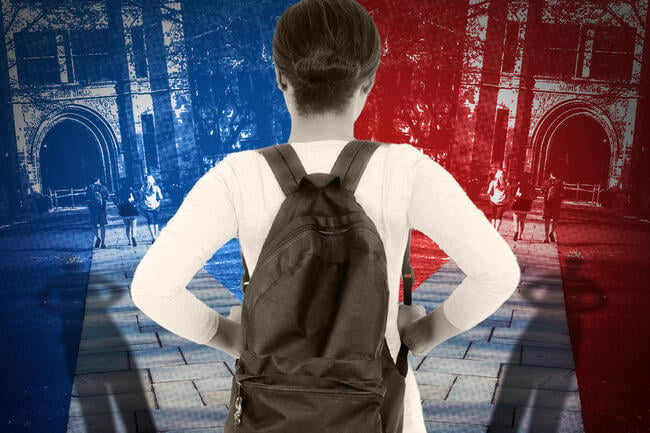You have /5 articles left.
Sign up for a free account or log in.

A new study details how students’ political beliefs could affect their choice in college.
Photo illustration by Justin Morrison/Inside Higher Ed | f11photo and michaeljung/iStock/Getty Images
College students are willing to pay more than an additional $2,000 in tuition to attend a college where fewer students hold political beliefs that oppose their own, according to a new working paper analyzing how students’ political views impact college choice.
Researchers conducted an experiment in which current college students were presented the details of hypothetical institutions of higher education, including academic quality, location, cost and the political makeup of the student body. From there, they were asked which institution they’d prefer to attend.
On average, liberal students indicated they would be willing to pay $2,617 more to attend a college with a 10-percentage-point lower share of conservative students, and conservative students indicated they would be willing to pay $2,201 for a 10-percentage-point lower share of liberal students. Those numbers are about on par with how much students would be willing to spend based on other characteristics, like better academic quality or a location closer to home.
“Our findings suggest that college choices in the United States are increasingly shaped not just by academic or financial considerations but by political identity as well. These results have several important implications for both higher education and American society more broadly,” the researchers wrote in the report.
Student bodies have also become more polarized over the past several decades. The researchers analyzed about 40 years of the Freshman Survey from the University of California, Los Angeles’s Higher Education Research Institute, which includes the political leanings of over 15 million first-year college students. They found that colleges that leaned liberal in the 1980s have grown more liberal, at least among their freshman classes; the same is true for colleges that leaned conservative.
Conservatives have long argued that colleges are liberal bubbles, unwelcoming to conservative students. But this study, which was published this month by both EdWorkingPapers and IZA–Institute for Labor Economics, comes at a time when concerns about political polarization and Americans’ declining ability and willingness to engage in civil discourse—especially on college campuses—are particularly high. Since pro-Palestinian protests erupted on college campuses in 2023, pundits on all sides of the issue have struggled to find ways to encourage students to participate in civil dialogue with those they disagree with.
More recently, Charlie Kirk, a conservative activist who founded the right-wing student group Turning Point USA, was killed during an event at Utah Valley University last week; though the alleged shooter only attended a university for one semester before later enrolling in Dixie Technical College, far-right commentators have begun using him as an example of liberal indoctrination at universities.
Riley Acton, an assistant professor of economics at Miami University, said she and her two co-authors were inspired to investigate the relationship between college choice and students’ politics as the country has grown increasingly polarized—and as a growing body of research has shown how that impacts people’s day-to-day decision-making.
“We know from other social science research across a range of disciplines that political identity is increasing affecting people’s choices and behaviors, everything from where they live to who they want to date to what stores they spend their money at,” Acton said.
Chris Teare, a certified educational planner and professional member of the Independent Educational Consultants Association with decades of experience in college counseling, said that he and his colleagues have worked with numerous students in recent years whose politics are impacting their choice of college. For some, that means avoiding states that have outlawed abortion. Others aim to leave the South in general.
He said he hopes he’ll be able to change the minds of students who refuse to go to schools that, other than politics, would be a great fit.
“The idea that you would be willing to pay more money to affirm what you already believe—to me, that seems to miss the point of an education that’s going to stretch you, challenge you and expand your view of the world as you get ready for what will hopefully be decades of adult life that will present new challenges to you over and over and over again,” he said.
‘Deeper Into Our Bubbles’
Despite colleges becoming more polarized over the past four decades—and student bodies over all moving to the left since the 1980s—the report also shows that fewer than half of students self-identify as liberal at the majority of institutions.
Still, the researchers note that if students continue selecting colleges where the student bodies align with their own political beliefs, colleges may become more homogeneous. And as students form personal and professional relationships on their campuses, that homogeneity could spread beyond the university walls.
Acton also noted one place where the study could differ from students’ real-life college choices. The experiment presents students with concrete statistics about the percentage of liberal, moderate and conservative students—information most students wouldn’t have available to them (although some college review sites, like Niche, provide self-reported student data).
“It is possible for students to get some of this information, but it might not be as salient in college’s marketing materials or college tours as we’re making it in this experiment,” she said.
Jeffrey Kidder, a professor of sociology at Northern Illinois University and the co-author of The Channels of Student Activism: How the Left and Right Are Winning (and Losing) in Campus Politics Today (University of Chicago Press, 2022), said that, anecdotally, he interacts with students regularly who are still interested in engaging with people whose political beliefs differ from their own. (Kidder was not involved in the research.)
But if the findings are accurate, he said, they’re concerning.
“Digging deeper into our bubbles isn’t going to help the polarization in our society,” he said. “College is one of the places, at least traditionally, people have been able to engage with different types of difference.”
Additionally, one of the best ways advocates have found to get students to participate in dialogue with those they disagree with is to ensure they have the opportunity to interact with those people in classes, residence halls and dining halls—places where they can come to see each other as people, rather than opponents.
Although Kidder thinks that campuses can still promote those interactions even on a campus where one political affiliation is a small minority, “you’re less likely to have a dorm mate or someone sitting in the cafeteria with you that has different views. I guess you’re less likely to encounter that, for sure. Just the law of averages.”




